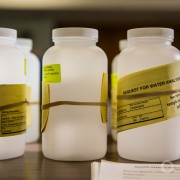Broken Water Systems Reflect Midwest Election Revolt
Trump triumphs in Rust Belt regions with neglected water infrastructure.

A Detroit street where water shutoffs occurred in 2014. Detroit is one of 14 Michigan cities whose population shrank in the last three decades. Photo © J. Carl Ganter / Circle of Blue
By Brett Walton, Circle of Blue
The electoral realignment in Ohio, Michigan, Pennsylvania, and Wisconsin, all of which voted for Donald Trump after years of Democratic allegiance in presidential elections, coincides with a breakdown of urban water infrastructure, concerns about water affordability, and the deteriorated condition of what had been America’s 20th century industrial core.
Trump gained ground in many of the 14 mid-size and large cities in Michigan and 14 more in Ohio — out of 99 in the country — that a recent U.S. Government Accountability Office report found had declined in population over the last three decades.
Many of those same cities also face a water crisis. They manage water systems that are much larger than the current population can afford to maintain. Worse, the facilities are outdated. Sewers spill water into rivers and lakes during heavy rains. Lead pipes contaminate drinking water in Flint and other cities. Water mains crack and rupture.
The deteriorated urban conditions, economic turmoil, and dilapidated water systems turned out to be predictive in projecting Trump’s capacity to attract unexpectedly large vote totals in former Democratic strongholds. One by one on election night the bricks fell in the Democrat’s “blue wall” — the Rust Belt states that were supposedly safe havens for Hillary Clinton. Ohio, the harbinger of the earthshaking reversal, toppled early in the evening. When Pennsylvania, Michigan, and Wisconsin later flipped for Donald Trump, the outcome was sealed.
Tim Ryan, a Democrat, represents Ohio’s 13th congressional district, a slice of northeastern Ohio that includes the cities of Akron and Youngstown. Ryan was re-elected on November 8 but his district turned against Clinton. Mahoning County, home to Youngstown, backed Obama in 2008 and 2012, both times with over 62 percent of the vote. This year, Clinton received less than 50 percent support and 18,000 fewer votes than Obama.
Youngstown’s population has fallen by more than 60 percent since 1960. Nearly all of the city’s 750 miles of water mains need to be replaced. In a money-saving move, the city is eliminating water and sewer service to abandoned areas and barricading roads that are empty of houses within a roughly one-square-mile zone in the city’s northeast corner.
“It’s a mess,” Bill D’Avignon, deputy director of planning for Youngstown, Ohio, said with a hollow laugh during an interview with Circle of Blue. “It is an aging infrastructure that has not been on an adequate replacement schedule. We’re replacing about one mile per year. We’re on that 750-year replacement cycle.”
2016 Election Changes Political Map
Other shrinking, water-stressed metropolitan areas in the Midwest follow a similar pattern. Though the urban cores remain staunchly Democratic, Clinton earned far fewer votes than Obama while losing ground in the suburbs. In some cases, the reversal was enough to turn the county from Democratic to Republican.
Genesee County, Michigan, where Flint is located, gave Clinton 26,221 fewer votes than Obama received four years ago. Trump, meanwhile, got 12,358 more votes than Republican nominee Mitt Romney did in 2012.
Wayne County, Michigan, which encompasses Detroit, gave the Democrats their smallest share of the presidential vote since 1992 while Trump earned 15,179 more votes than Romney.
Montgomery County, Ohio, is home to Dayton, where the population declined 27 percent since 1980. This year, Montgomery flipped for Trump, the first time a Republican won the county since 1988.
In Saginaw, Michigan, a city of 49,000, Republican presidential votes held steady while the number of Democratic votes dropped by 3,252. Saginaw’s population dropped 36 percent since 1980. The surrounding county, also named Saginaw, backed Trump. The last Republican to carry Saginaw County was Ronald Reagan, in 1984.
The consequences of the Republican triumph for Rust Belt water systems is uncertain. Democratic colleagues have attempted to direct federal aid to the region without success. Rep. Ryan was one of six Democrats from Michigan and Ohio who introduced legislation in the House in February to provide water bill subsidies for poor households. The program would be modeled after a federal program for home heating and electricity. The bill drew little support and did not move out of committee.
Will Water Systems Get Fixed?
Fixing the region’s water systems will be expensive. The federal government has ordered sewer improvements in Akron, Cleveland, Detroit, Toledo, and Youngstown that will cost hundreds of millions or billions of dollars, to be paid largely by city residents via rate increases. Akron, for instance, raised rates by nearly 70 percent last year to pay for a $US 1.4 billion sewer overflow project. Replacing all of Youngstown’s pipes would cost some $US 390 million. Water for the poorest people in these cities is becoming unaffordable, the shutoffs in Detroit being the most glaring example.
Officials in the region also recognize that they must rethink their cities. In a 2005 update to its comprehensive plan, Youngstown acknowledged that it must shrink its footprint. “We’re one of the only cities that has embraced that concept of losing population,” D’Avignon said. Decommissioning four miles of roads and three miles of water mains and sewer lines in the city’s east side is a step in that direction.
“This is a problem that is nationwide and not going away,” Rep. Ryan told Circle of Blue in a statement, referring to the high cost of repairing the region’s water systems. He supports a federal solution. “That is why we need Congress to pass an infrastructure bill that puts real money behind fixing our crumbling roads, unsafe bridges and our failing sewer systems. Every day that we wait to solve these problems, the worse they get. We cannot afford to wait any longer.”
Rust Belt cities might have to wait. The House and Senate seem unable to compromise on a water infrastructure bill. Each side passed a slightly different version of the Water Resources Development Act earlier this year. The Senate bill would inject $US 34 billion over five years into a low-interest federal loan program for drinking water and sewers. The House bill continues no such provision.
A Trump presidency could offer fresh opportunity. During his campaign Trump pledged renewed attention to the nation’s infrastructure, calling for a $US 1 trillion investment. That plan, thin on details and relying heavily on private sector funding, emphasizes roads, bridges, airports, and other transportation projects. It is a campaign pledge that he has not rescinded or revised.
Water and sewer systems would conceivably play a role, given Trump’s statement to the New York Times on November 22 that “crystal clean water is vitally important.” Any infrastructure plan, however, must go through Congress, which shows little willingness to spend big on public works.
Brett writes about agriculture, energy, infrastructure, and the politics and economics of water in the United States. He also writes the Federal Water Tap, Circle of Blue’s weekly digest of U.S. government water news. He is the winner of two Society of Environmental Journalists reporting awards, one of the top honors in American environmental journalism: first place for explanatory reporting for a series on septic system pollution in the United States(2016) and third place for beat reporting in a small market (2014). He received the Sierra Club’s Distinguished Service Award in 2018. Brett lives in Seattle, where he hikes the mountains and bakes pies. Contact Brett Walton










